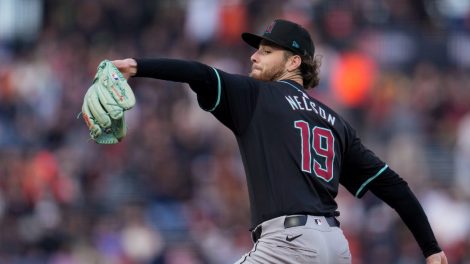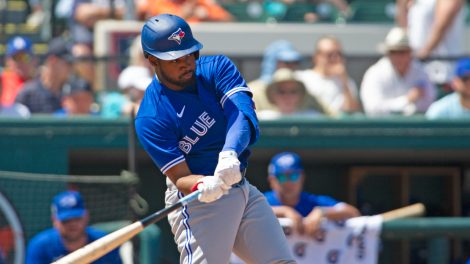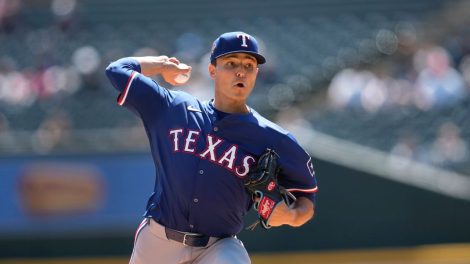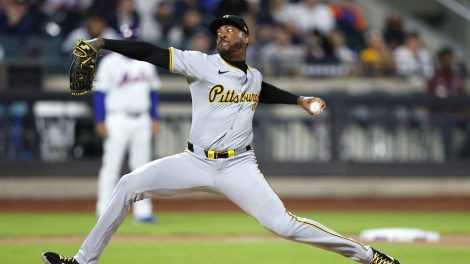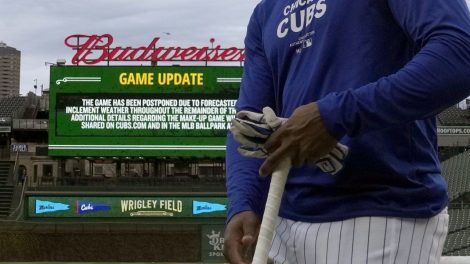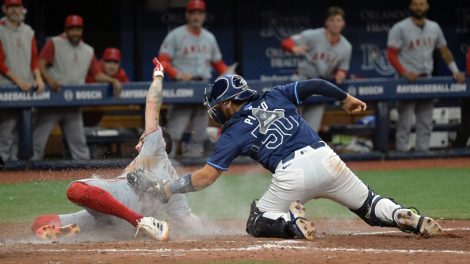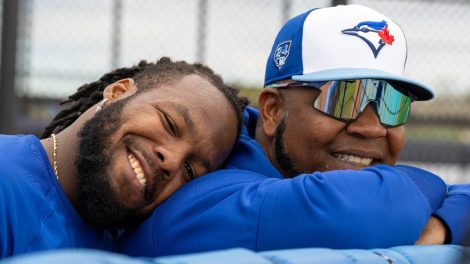Blue Jays Confidential asks a panel of Sportsnet Blue Jays analysts to weigh in on issues big and small with the team, and around Major League Baseball.
Starting this off-season, we’ll be giving different Sportsnet personalities a chance to pose their burning questions to the panel. This week, Arden Zwelling wants to know what everyone is expecting from Chase Anderson, why all’s quiet on the Ken Giles front, and which example of front-office corporate-speak the panel’s tired of hearing.
1. Alternatives, sustainability, process — MLB executives continue to sound more like business school professors than baseball fans as they search for the most evasive, nebulous corporate-speak with which to describe their off-season strategy. If you could eliminate one overused buzz word or phrase from the vocabulary of club execs, what would it be?
Shi Davidi (@ShiDavidi):
Oof, it’s so hard to choose. Why isn’t all of the above an option? I really miss the unfiltered bluntness of J.P. Ricciardi, who was the first GM I covered regularly and, I really recognize now, a total outlier. He said what he thought and wasn’t worried about how it played. People tend to remember “it’s not a lie if we know the truth,” and this criticism of Adam Dunn: “Do you know the guy doesn’t really like baseball that much? Do you know the guy doesn’t have a passion to play the game that much? … I don’t think you’d be very happy if we brought Adam Dunn here.”
My personal favourite came from a conversation after the Blue Jays claimed Doug Davis off waivers. He was asked, why Davis? “Why not?” he replied. “I wouldn’t say that he was a guy we were doing cartwheels over, but he’s a guy that’s had success in the past … Basically, we took a flyer.” Later he added, “I don’t want you thinking Andy Pettitte is coming here to pitch on Saturday.” Can you imagine how that would light up social media today? Sure would put a pulse back into the game.
Jeff Blair (@SNJeffBlair):
“Prospect capital.” It’s prospects.
Ben Nicholson-Smith (@bnicholsonsmith):
Well, there’s no shortage of choice on this front, is there? I’ll go with “asset.” As in: “With four years of club control remaining, he’s one of the organization’s most valuable assets.” I’m sure I’ve been as guilty as anyone of using this word over the years, so I’m far from blameless here, but it’s probably time to stop. These players are experts in their profession, not lines on a spreadsheet. Why not just say a player has substantial trade value or say any team would benefit from his skills?
Major League Baseball appears to agree with this, by the way. I heard recently that MLB is trying to dissuade big-league GMs from describing players using terms like “asset” and “controllable.” Probably for the best.
Arden Zwelling (@ArdenZwelling):
I’m not a fan of “controllable” — it’s another way of saying, “We don’t have to pay this guy what he’s worth and he can’t do anything about it.” New MLB players are already entering an economic system — one they had zero input in establishing — that allows clubs to unilaterally suppress their salaries to essentially the league minimum through their first three seasons and strictly controls the raises they can receive through an outmoded arbitration process over the next three. Referring to athletes as “controllable,” as if the goal is limiting payroll rather than fielding the best team, only serves to remind everyone how little agency young players have.
Mike Wilner (@Wilnerness590):
There are so many that seem to have stuck in the craw of fans and observers over the years. “Years of control” was always a big one. “Process” bothers a lot of people. For me, it’s less one of the corporate-speak terms as it is just an unnecessary one. Why do we need to talk about “handedness”? It just seems like an additional complication. Just say you like that a guy hits left-handed. Simple.
[snippet id=4722869]
2. What’s a reasonable expectation of Chase Anderson this season in terms of games started, innings pitched and ERA?
Shi Davidi
Some of the public projections for his 2020 are pretty generous in terms of starts and innings, with Steamer pegging him at 31 and 173, although the 5.49 ERA is worrisome. If the Blue Jays get 25 starts and 140 innings at an ERA in the 4.80-5.15 range from Anderson, they’d be thrilled. Barring injury, that’s reasonable.
Jeff Blair
25 starts, 160 innings pitched, 5.01 ERA.
Ben Nicholson-Smith
Let’s say 25 starts at five innings per start for 125 innings. As for the ERA, major-league starters averaged a 4.54 ERA in 2019. That also happens to be Anderson’s lifetime FIP. So, I’ll say it’s realistic to expect 125 innings of 4.54 ERA baseball from the new addition.
Arden Zwelling
I think there will be an exchange rate paid for entering the AL East as a low-strikeout, homer-prone pitcher who gives up a lot of hard contact. Admittedly, many said the same of Marco Estrada. But there’s little to suggest Anderson possesses a pitch as devastating as Estrada’s changeup. I bet he pitches behind an opener frequently, which would limit his starts. And I doubt he ever sees a batting order a third time, which puts a cap on his innings. I’ll say 10 starts, 120 innings, 4.90 ERA.
Mike Wilner
Having ridden the ups and downs of Mr. Anderson for years in my personal baseball geek-league, I feel like I know him pretty well. I think we’ll see much more good than bad from him over a full season’s work in the rotation (though there will be a few clunkers), but I think he makes 30 starts (if healthy, of course). I wouldn’t be surprised to see 180 or so innings out of him and an ERA in the low 4.00s.
[relatedlinks]
3. If there’s a scarcity in this winter’s free-agent market, it’s high-leverage relief. But so far it appears Toronto has found little traction with regards to a Ken Giles trade. Why do you think that is? And when Blue Jays pitchers and catchers report to Dunedin in February, do you think Giles will be among them?
Shi Davidi
Let’s start with the why here and it’s simple – leverage. The Blue Jays have very little of it, although the Atlanta Braves pulling Will Smith and Chris Martin off the market may help to change that a bit. Everyone knows Ross Atkins tried unsuccessfully to trade Giles at the deadline and if they intended to keep him, they would have already extended him given the closer’s stated interest in an extension. Factor in lingering worries about Giles from his time in Houston, and it’s hard for the Blue Jays to get close to full value for him. The trade deadline may present a better opportunity for them, although I can still see them getting something done with him this winter.
Jeff Blair
With Will Smith already off the board I would expect the market for Giles to pick up at the winter meetings, but I still believe he will be with the team in spring training and will either be signed to a contract or traded at the deadline.
Ben Nicholson-Smith
While the Blue Jays would listen on Giles, I expect him to be there when spring training starts a few months from now. Then if the Blue Jays play well and stay in the wild-card mix, he’s around to help. And if the Blue Jays are losing more games than they win, he’ll be traded over the summer when relievers are traditionally in high demand.
Arden Zwelling
I think best course for the Blue Jays is trading Giles this off-season when his value is as high as it’s going to be. If the club tries to play the Giles market out until the trade deadline, they’re inviting a sour turn of fate in the form of injury or poor performance. Remember, Giles probably isn’t a Blue Jay right now if not for his health uncertainty in July. The fact that Aroldis Chapman and Will Harris went off the board so quickly suggests that teams looking for high-leverage relief recognize there’s a supply shortage. So, it’s strange to me that there hasn’t been more chatter. But maybe it’ll come later in the winter once the big dominoes have fallen and teams have shifted priorities. I bet the Blue Jays ultimately find a deal they like before spring training.
Mike Wilner
I think the relief market, more than any other, takes the longest to really shape itself up, and that’s why we’re not hearing much about Giles. I do believe the Blue Jays’ best course of action is to deal him this off-season. I think the daily, “Can he pitch tonight?” drama leading up to the trade deadline this past season is something they want to avoid. I’ll be surprised if he’s still a Blue Jay come spring training.
[snippet id=3305549]
4. Like most pro sports, MLB is trending younger. During the 2010 season, 23 players aged 34 or older qualified for the batting title. By 2016, that number was down to 17. This year it was only 10. Plenty of ballplayers can put up spectacular seasons in their 20s – what’s rare is those who remain productive and playable deep into their 30s. Who among current Blue Jays position players do you think is most likely to still be qualifying for batting titles in their age-34 season and beyond?
Shi Davidi
I’m going with no one on this, in part because the team is so young (Bichette could wrap up a 13-year career before he’s 34) and in part because the pace of change is so rapid, the evolutions in player development may simply create too much upward pressure and force older players out of the game.
Jeff Blair
Bo Bichette. He has the type of body that should be easily maintained and seems smart enough to do so. I just don’t think you can go wrong expecting the very best from this kid.
Ben Nicholson-Smith
I still think the most likely candidate is Vladimir Guerrero Jr., who held his own at the plate as a 20-year-old. Right behind him you have Bo Bichette, who hit even better than Guerrero Jr. at age 21. If there’s a third candidate, I’d go with Lourdes Gurriel Jr., who has quietly hit 31 home runs with an .819 OPS in his first 149 games as a big-leaguer. For what it’s worth, his brother Yuli just hit .298 with an .884 OPS at age 35.
Arden Zwelling
I liked the idea of this question until I had to answer it. It’s easy to envision Vladimir Guerrero Jr. following a similar career trajectory to Edwin Encarnacion, Bo Bichette developing into a Justin Turner type, and Cavan Biggio having some longevity in this game with his conditioning, positional versatility and plate discipline. Not to mention the fact Lourdes Gurriel Jr.’s brother, Yuli, just put up a three-win season at 35. But I’ll bet on Bichette playing well into his mid-30s. When he says he wants to be one of the best players ever, he means it.
Mike Wilner
Bo Bichette and Vladimir Guerrero, Jr. For Vladdy, it may very well be as a DH for even 10 years leading up to that, but the hitting skill is absolutely there. Lourdes Gurriel Jr. has a decent shot, too – there hasn’t been a lot of mileage put on his body the last three years because of all the injuries.
5. Do you see any value in the Blue Jays adding a veteran utility type — think Brock Holt, Jose Iglesias, Asdrubal Cabrera — in the same vein as last winter’s low-risk signings of Freddy Galvis and Eric Sogard? Or should the club prioritize giving opportunities to internal options like Richard Urena and Santiago Espinal?
Shi Davidi
At the risk of sounding like a broken record, just sign Mike Moustakas to play first, second, third and DH and make this a better team. All the guys you listed will want ABs and if the Blue Jays don’t make an impact add, better off giving the ABs to young players who might develop into something. But they really should be aiming up market and using an internal option like the out-of-options Urena or Espinal to fill a utility role.
Jeff Blair
They’re a year away from being in the type of games where experience matters. Just gimme the most talented.
Ben Nicholson-Smith
Adding backup infield help makes sense to me and the Blue Jays are interested in this market, but I don’t imagine it’d be an easy sell for most veteran free agents. With Bichette, Guerrero Jr. and Cavan Biggio in place as starters, there’s not necessarily tons of playing time available in Toronto. If you’re Iglesias, I think you can find a better opportunity and I’d want more defence than you’d get from Cabrera, whose range seemed extremely poor last year (at least to my eye). If the Blue Jays add on this front, I think it’s a minor-league deal in January or February.
Arden Zwelling
If the Blue Jays could get someone like Brock Holt — the left-handed hitter put up a 105 OPS+ over the last two seasons while playing passable defence at six different positions — on a cost-effective, one- or two-year deal, I think it’d be worthwhile. It helps to have that versatility and veteran approach. Plus, injuries happen and the Blue Jays are currently looking pretty thin around the infield behind the incumbents at each position. And as Sogard proved last season, that kind of player can carry some value at the trade deadline.
Mike Wilner
I think veteran players who know their role, are productive when they get a chance to play and are good in the room are always beneficial, regardless of where a team is in its competitive cycle. Galvis was brought in to be a starter, Sogard not so much, but they both wound up being godsends. I’m all for it, as long as it’s the right type of guy.



